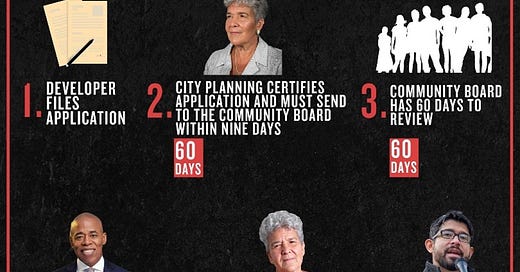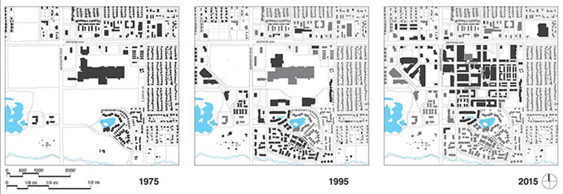Belmar, CO as a model for land reform
Land use successes, calls for system reform, and challenges
Conversion of commercial spaces into residential – done the right way
In the year 2000 Lakewood Colorado had a dying mall on its hands. Originally one of the country’s biggest indoor shopping malls, Lakewood’s mall was now largely (+60%) vacant. In light of this and with a stroke of innovations, city officials worked with developers to flex the zoning and to allow for a redevelopment program to move forward. What ensued was a great feat in urban renewal. Developers built a downtown area with +2,000 homes, 9 acres of parks and public plazas, +281K SF of office, national credit tenants, and dozens of other retailers that contribute to over $200M in annual retail sales. Officials named the new neighborhood Belmar. The transformation is palpable and is an inspiration for commercial -> residential land use change.
Belmar, Colorado’s geographic density over time. Big changes!
NYC, on the other hand, has struggled to simplify the converting of commercial spaces into residential apartments. Last year, Former Governor Andrew Cuomo signed legislation to encourage the transformation of distressed hotels into affordable housing. New Governor Kathy Hochul added a few bells and whistles to the bill and claimed her own new piece of legislation on the topic. And yet, converting property in NYC that doesn’t conform to existing zoning still feels like going against the grain. Some other regions in the U.S have attempted to do the same with mixed results.
California – AB 2011 allows multifamily projects to cut the local review line and exempts them from some of the state’s environmental requirements. The bill also makes it easier for developers to convert commercial sites into residential. This has passed.
Washington – H.B. 1782 would have required cities with populations of >20,000 to enable multifamily development in single family zoned areas. This didn’t pass.
New Hampshire – S.B. 400 would have set-up a reward system for cities that were ‘Housing Champions,’ or that that actively took steps to encourage the development of workforce housing. Amongst other things, these local towns would benefit from increased state funding If they hit certain benchmarks. This didn’t pass either.
There are merits and draw backs to top-down state zoning policies. Some might argue that state policies overlook the specific infrastructure, traffic issues, and downstream effects on schooling systems. On the other hand, to leave cities without state leadership could rob them of their North Star and it would leave cities with less funding than if the state stood behind these policies. Finding ways to encourage additional affordable housing will not look the same in every locale. I also don’t think it will always work the first time around, as evidenced by NYC’s case. It will be interesting to see how things develop in California in the wake of AB 2011’s passing. The changes made in California embody many of the recommendations made for ULURP reform and could shine a light for NYC to follow!
Reforms to the uniform land use review procedure (ULURP) in NYC to speed up re-zonings
A new paper has emerged advocating for the reform of NY’s land use process. It is available here. We have summarized it for you below.
According to the research paper, the current process for spot rezonings “takes too long, is too contentious, is too expensive to navigate, and discourages applicants from coming forward with new ideas.” Even more problematic, the authors go on to explain, is that the trend is increasingly toward discretionary decision making, rather than clearly defined guidelines and more rule-based decision making. Every time there is a zoning change requested, it turns into a long, arduous rigmarole.
Reminder: the current ULURP flow-chart can be viewed here. It’s long & not very pretty.
This is a good time to release a report like this because Mayor Adams made clear his support for reforming the land use policies in NY earlier this summer.
Solutions proposed by the piece center around selective enforcement of the environmental study requirements, while also focusing on creating more rule-based guidelines that inform and quicken the processing of applications at the state and city level. For instance, California allows some projects “less than 49 units to be built as-of-right,” and these projects sans-environmental review get completed in 5 to 10 months rather than the 31 months required for projects with environmental reviews.
New development proposal in Throggs Neck, Bronx draws mayor’s attention
In response to the ever-present affordable housing crisis, NYC Mayor Eric Adams is breaking protocol and standing in opposition to a local city council member on a land rezoning.
Marjorie Velasquez represents City Council District 13 in the South Bronx and because of city council member deference the decision to greenlight the project for ULURP rests with her.
The project is meant to deliver 4 new buildings with a total 349 multifamily units.
The proposed development would take place in a residential area with wide lots, big backyards and few buildings taller than 3 stories. Only 58 units of income restricted housing have been built there since former mayor DeBlasio came into office in 2014.
The contention exists around the lack of ‘affordability’ in the project – 94 units are currently earmarked as ‘affordable’ - and the disruption to existing community members.
Bruce Teitelbaum, the developer behind the withdrawn One45 project, has pivoted away from his original plan to deliver 917 multifamily units due to difficulties faced with city council. Instead, he will use the 589 x 100-foot land plot as a truck depot. This signals that he is going to take his time to plan for future uses of the lot and that he recognizes there is no straightforward path to develop.
Sources: The Real Deal, ULURP Reform, Law360, CNU
Originally published in September 2022




